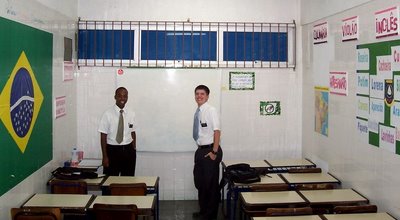Literacy In Brazil

"My training last week was on how to use the scriptures better in our teaching. Me and my companion are really trying to apply it but its tough. Here is why: I am more educated than 85% of SP, for the mere fact that I have graduated from high school. Only two of my four Brazillian comps graduated from high school, Elder Martins and Elder Silveira. So sometimes, when we use a scripture it confuses people because the scriptures are in a very formal languange and I sometimes feel that it makes a lesson worse than better. So what I tried to show my district is how to take one scripture, write it out on a piece of paper, in big letters, for the investigator to see, then explain the whole lesson off of that one passage. Don't ever leave that passage. Then the person could understand and maybe apply it a little better than normal. It's sad, the illiteracy rate here is way high and I feel bad for kids who have to quit school when they are like 15 so they can go find a job to help support their family. Ah, it's a way sad situation but hopefully us bringing the Gospel to them can make them feel a little better."
In 1990 it was estimated that 81 percent of the total population above age fifteen was literate, or 19 percent illiterate (based on the inability to sign one's own name). The level of functional illiteracy--that is, the inability to read newspapers and write letters--was not measured but was certainly much higher (an estimated 60 percent). As with most social indicators, illiteracy is highest in rural areas of the Northeast and North, where the figures are comparable to those in Africa, and lowest in urban areas of the Southeast and South, where the figures are comparable with those in the developed world. For example, southern towns had an adult illiteracy rate of only 10 percent in 1991, while the rate for children between the ages of eleven and fourteen was only 3 percent.
Literacy is strongly associated with income. When the population is divided into five income strata, illiteracy is ten times greater in the stratum with the lowest income. The illiteracy rate rises by age- group. The 1991 census also showed a strong racial gradient, with illiteracy levels of 11.6 percent among whites, 27.4 percent among mulattoes, and 29.9 percent among blacks. Differences by gender were not strong. Because of disappointing results when the federal government undertook a nationwide adult literacy campaign, the Brazilian Literacy Movement (Movimento Brasileiro de Alfabetização--Mobral), the emphasis shifted in the 1960s and 1970s to reaching children through the school system.


0 Comments:
Post a Comment
<< Home